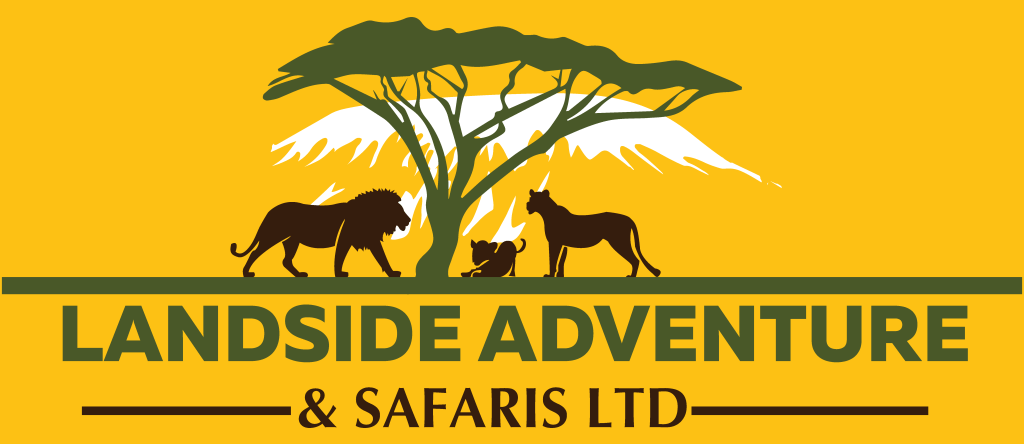6 Days Kilimanjaro Climb Rongai Route
Overview
Start and end at Kilimanjaro airport! With 6 days Kilimanjaro climb Rongai route, 6 days on the mountain & 2 nights hotel accommodation in Moshi. The north side of Kilimanjaro sees less rainfall and is therefore the first choice outside peak season. Do you want to enjoy the Kilimanjaro in relative peace? The Rongai route is a good choice. Although popularity is increasing each year, the numbers are much lower than on routes such as the Machame route and the Marangu route. Are you looking for a less technical Kili route? The Rongai is your match. It is one of the routes that you can hike with less experience. The slopes are less steep and are easy to hike. The landscape on the north side is less varied than on the other side of Kilimanjaro, but for that, you get a unique landscape in return.
This package provides everything you need for your hike: experienced mountain crews, high-quality group equipment, accommodation in tents, and nutritionist-designed meals. Before and after the adventure you will stay in a comfortable hotel with caring staff, hot water, reliable Wi-Fi, a restaurant, and a swimming pool. Only guides with a Wilderness First Responder certification are assigned to lead a party. Other safety measures include a supply of oxygen cylinders, complete medical kits, and two daily compulsory medical check-ups.

Itinerary
Arrival
Pick up at Kilimanjaro airport and drive to Kili Wonders Hotel in Moshi Town.. Enjoy your lovely stay in this Hotel with comfortable beds and a hot shower. We recommend that you try and get an early flight ahead of your 6 days Kilimanjaro climb rongai route which will start the following day.
- Accommodation: Kili Wonders Hotel
- Meals Included: Breakfast
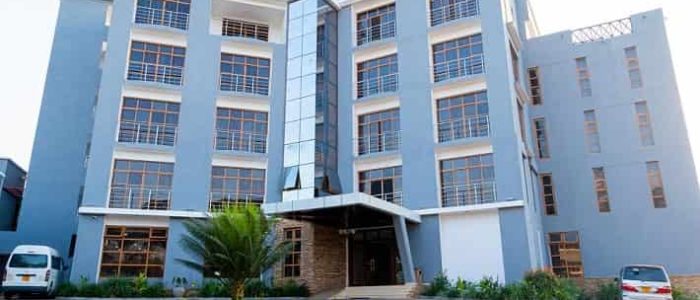
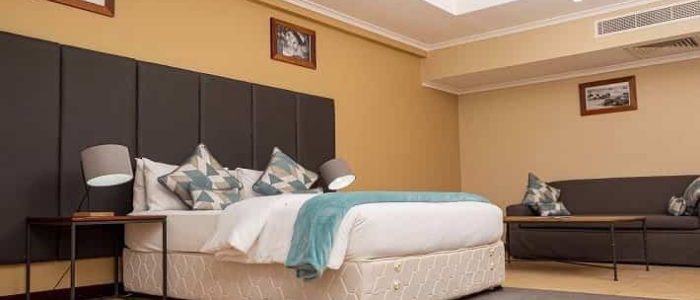
Moshi – Nalemoru Gate (1,990 m) – Simba Camp (2,625 m)
Duration: 02:50 hrs
Distance: 6.86 km
Following breakfast, a drive will transport you around the northwestern flank of Mount Kilimanjaro. In a span of 3 to 4 hours, you’ll arrive at the Nalemoru Gate. Upon the fulfilment of the registration process and the distribution of your belongings amongst the porters, your remarkable journey commences.
The pathway traces the contours of mountain farmers’ fields and pine forests before delving into the sparser expanse of the mountain forest zone. It’s in this region that you may have the opportunity to encounter black and white colobus monkeys in their natural habitat.
After a hike of approximately 3 to 4 hours, you’ll reach the Simba Camp, where you’ll settle in for the night.
- Accommodation: Kilimanjaro Camping
- Meals Included: Breakfast, Lunch, Dinner

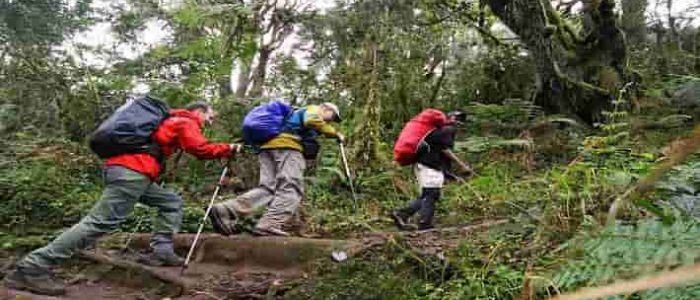
Camp (2,625 m) – Kikelewa Camp (3,630 m)
Duration: 05:00 hrs
Distance: 11.6 km
Today’s trek takes you through the heather and moorland zones, presenting striking vistas of Mawenzi and the expansive Kenyan steppes. The grandeur of the scenery is truly remarkable. At the Second Cave (3,450 m), you’ll halt for lunch, followed by a brief respite. Post-break, you’ll navigate the rolling terrain en route to Kikelewa Camp.
Kikelewa Camp offers remarkable panoramas, and after a demanding day of climbing, it provides a serene environment to unwind and soak in the tranquillity of the surroundings.
- Accommodation: Kilimanjaro Camping
- Meals Included: Breakfast, Lunch, Dinner
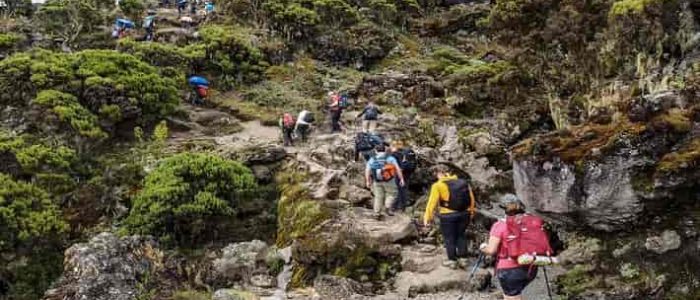

Kikelelwa Camp (3,630m) – Mawenzi Tarn Hut (4,330m)
Duration: 02:10 hrs
Distance: 3.7 km
The next phase of our journey entails a brief yet invigorating ascent to Mawenzi Tarn, nestled at an elevation of 4,330 meters. This segment of the climb is characterized by its short duration but steep incline, offering a burst of physical challenge amidst the breathtaking landscapes.
The afternoon following our arrival is unstructured, allowing you the freedom to engage in activities that contribute to your acclimatization process. This could involve relaxation, gentle walks, or simply absorbing the unique atmosphere of this high-altitude haven. As the sun casts its gentle glow over the landscape, you’ll have the opportunity to truly connect with the mountain and prepare for the challenges and wonders that lie ahead.
- Accommodation: Kilimanjaro Camping
- Meals Included: Breakfast, Lunch, Dinner
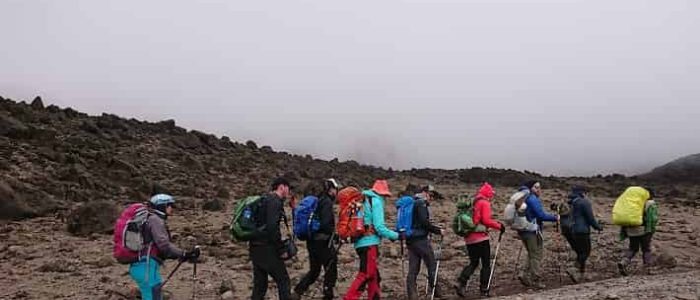
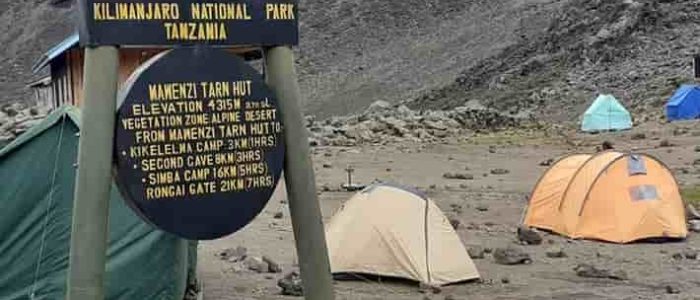
Mawenzi Turn (4,330m) – Kibo Hut (4,703m)
Duration: 03:10 hrs
Distance: 8 km
On this day, our path leads us across the barren expanse of the lunar desert that lies between Mawenzi and Kibo Hut (4700m). By early afternoon, we find ourselves at the base of the imposing Kibo Crater wall. The landscape we traverse resembles a desert of lunar-like qualities. The journey presents us with a stark and otherworldly environment, as we traverse this stretch that bridges the gap between Mawenzi and Kibo Hut.
- Accommodation: Kilimanjaro Camping
- Meals Included: Breakfast, Lunch, Dinner

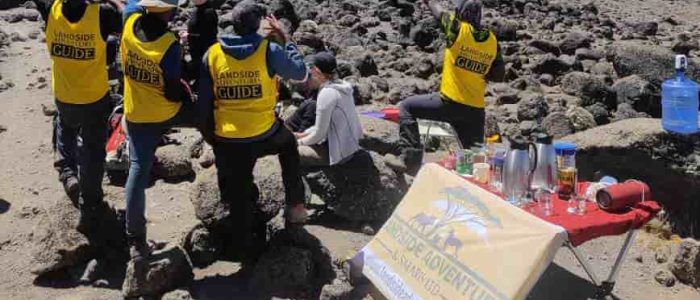
Kibo Hut (4,700 m) – Uhuru Peak (5,895 m) – Horombo Hut (3,700 m)
Duration: 10:25 hrs
Distance: 19.7 km
Under the cover of the night, as the lava ash remains frozen and lends ease to your steps, your journey commences. The ascent to the summit begins, a formidable and demanding undertaking illuminated solely by the stars above. Guided by their distant glow, you’ll pass the Hans Meyer cave at 5,200 meters, your path steadily rising with each step.
With the arrival of sunrise, you’ll stand proudly at Gilman’s Point (5,715 m), perched upon the crater rim. The frigid grip of the night gives way to the sun’s warmth, and you’ll find yourself enveloped in the awe-inspiring vistas that stretch before you. The ascent continues with newfound vigor, and after an additional 1 to 2 hours of steadfast determination, the crowning achievement awaits: Uhuru Peak at 5,895 meters.
The descent retraces your journey along the same route, yet now the once-frozen lava ash yields to the touch of the sun, enabling a swift and spirited descent. Upon your return to Kibo Hut, a heartening meal awaits, welcoming you back and providing a much-needed chance to restore your strength. After a pause of 1 to 2 hours, your journey continues, guiding you downward to the embrace of Horombo Hut (3,700 m).
- Accommodation: Kilimanjaro Camping
- Meals Included: Breakfast, Lunch, Dinner
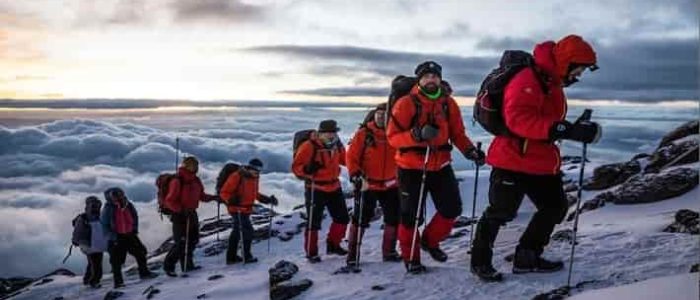
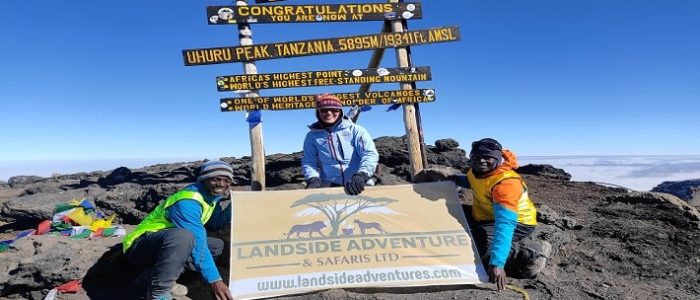
Horombo Hut (3,700 m) – Marangu Gate (1,860 m) – Moshi
Hiking distance: 19 km
Hiking time: 5–6 hours
You will be offered a warm breakfast in the morning, after which we will head for the Kilimanjaro National Park’s exit: Marangu Gate (1,860 m). After your descent, the whole group will congratulate you, and you will have the chance to share your opinions on the trip in the guestbook. Lastly, you will have lunch at the Marangu gate picnic site, present you with your commemorative certificates and then provide a transfer back to the hotel.
- Accommodation: Kili Wonders Hotel
- Meals Included: Breakfast
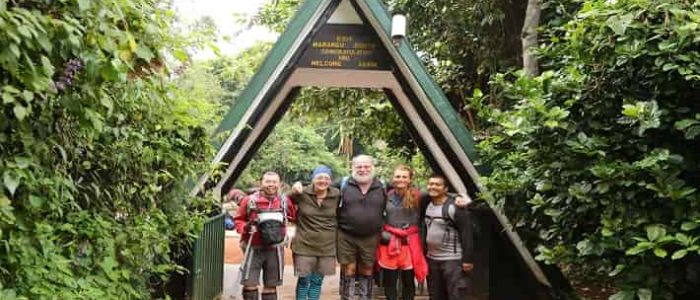

Departure Day
Hotel-to-airport transfer.
NB: Typical check-out time is 11:00 AM. Late checking out is available for guests with late flights, though they may incur extra fees.
Price Information For 6 Days Kilimanjaro Climb Rongai Route
Prices are per person on twin sharing basis; departures are guaranteed even with two persons!
2 Pax
3 Pax
4 Pax
5 Pax
6+
- Included
- Accommodation while on a trek
- All meals for vegetarian/non-vegetarian
- 2 Nights hotel before and after the climb
- All entry fees, camping fees, and Rescue fee
- Utensils, Awards Certificates of Achievements
- Professional Mountains Guides, Cook, and Porters.
- Treated drinking water,
- 4 Transfers from JRO to the hotel, from hotel to gate, from gate to hotel, and from hotel to JRO
- Excluded
- Tips & Visa
- Laundry services
- International flight ticket fees
- Alcoholic and non-alcoholic drinks
- All items of a personal nature such as telephone calls, faxes, emails etc
- Mountain trekking gears
Frequently Asked Questions
Know before you go
- Accommodation is on a sharing basis: you will share a twin/double room in the hotel, a night before and after the hike, If you travel alone, you will be matched with a same-gender adventurer. A single supplement room is available $350 for two nights if you’d prefer not to share a room on this trip.
- On the mountain you will sleep in the tents on your own mattress but share a tent with other travel companion. A single supplement tent is available $250 for the whole trip if you’d prefer not to share a tent on this trip.
- The diet includes energy-rich and highly nutritious meals prepared by professional high-altitude cooks
- This is a 6-day hike to summit Kilimanjaro but this package also includes 2 nights accommodation in a hotel (1 night before the climb and 1 night after)
Paperwork Needed
- Passport
- Visa (available at JRO)
- Vaccination/Immunization Papers
- Insurance
Do I Need to Carry All My Own Gear on Kilimanjaro?
Absolutely not! Because our trips are fully supported, our porters will carry most of your gear from hut to hut.
You only have to carry a small daypack with the things that you might need while hiking to the next campsite. Generally that would include extra clothing, rain gear, snacks and water.
Everything else goes into your duffel bag, which will be ready in your room by the hut you get to the camp.
Our porters will place your duffel bag and sleeping bag into a large, sturdy, waterproof bag with a roll-top closure.
Is There a Weight Limit for My Kilimanjaro Gear?
Our porters are limited to carrying 33 lbs (15 kgs) of your personal belongings. So be selective in what you take with you.
The most common mistake that climbers make is that they over pack and bring too much gear. If you are having issues getting under the weight limit, review your gear along with our gear list carefully and cut out any extra or unnecessary items
Note that all the gear that the porters will carry for you between campsites should be placed into the duffel bag, including the sleeping bag, but it is OK to pack the sleeping bag separately if necessary. If you rent a sleeping bag from us, note that the bag weighs 5 lbs 6 oz. and this weight does count against the 33 lb limit.
If you have excess weight, you will be required to hire an additional porter. It is rare to require an extra porter and should happen only in special cases, such as for carrying extensive photography equipment.
Can I Store Extra Luggage at the Hotel?
Yes. All extra luggage, items you will not use on your climb, such safari clothing, gear and equipment, can be safely stored at the hotel.
What Happens if My Baggage is Lost or Delayed?
If your baggage is lost or delayed, please notify us immediately upon your arrival so we can assist you in assembling the necessary gear. We will take you to local, independently owned gear shops in Moshi. But you might not be able to find what you need at these stores and the quality and condition of the gear might be substandard. Therefore, we strongly encourage you to carry on the most important pieces of gear as noted above.
We will make reasonable attempts to deliver delayed luggage to you on the mountain. All additional expenses that are incurred by us while resolving lost or delayed luggage problems must be reimbursed locally.
The gear required to climb Kilimanjaro is extensive. You are responsible for bringing personal gear and equipment while communal equipment (tents, food, cooking items, etc.) is provided
Below is a Kilimanjaro gear list of required, recommended and optional items to bring on your climb.
Technical Clothing
1 – Waterproof Jacket, breathable with hood
1 – Insulated Jacket, synthetic or down, with hood
2 – Soft Jacket, fleece or soft-shell
3 – Long Sleeve Shirt, light-weight, moisture-wicking (hood recommended)
1 – Short Sleeve Shirt, light-weight, moisture-wicking (optional)
1 – Waterproof Pants, breathable (side zipper recommended)
2 – Hiking Pants
1 – Fleece Pants, warm
1 – Shorts (optional)
1 – Long Underwear, moisture-wicking
4 – Underwear, moisture-wicking
3 – Sport Bra (women)
Headwear
1 – Brimmed Hat, for sun protection
1 – Knit Hat, for warmth
1 – Neck Gaiter, for dust, wind and warmth
Handwear
1 – Gloves, warm (waterproof recommended)
1 – Gloves, light
Footwear
1 – Hiking Boots or Shoes, warm, waterproof
4 – Socks, wool or synthetic
1 – Gaiters, waterproof (optional)
Accessories
1 – Sunglasses
1 – Backpack Cover, waterproof (optional)
1 – Water Bottle (Nalgene, 32 oz.)
1 – Water Bladder (Camelbak type, 3 liters)
1 – Towel, lightweight, quick-dry (optional)
1 – Pee Bottle, to avoid leaving tent at night (recommended)
Stuff Sacks, Dry Bags or “Ziploc”-Type Plastic Bags, to keep gear dry and separate. Note that there is a general ban on plastic bags in Tanzania, however Ziploc-type bags for toiletries are permitted for tourists.
Equipment
1 – Sleeping Bag, warm, four seasons*
1 – Sleeping Pad, inflatable (optional, foam pad provided)
1 – Camp Pillow, inflatable (optional)
1 – Trekking Poles, collapsible (highly recommended)*
1 – Head Lamp, with extra batteries
1 – Duffel Bag, 70L-90L capacity, for porters to carry your equipment
1 – Daypack, 30-35L capacity, for you to carry your personal gear
*may be rented on location
Other
- Toiletries
- Prescriptions
- Sunscreen
- Lip Balm
- Insect Repellent,
- containing DEET
- First Aid Kit
- Hand Sanitizer
- Toilet Paper
- Wet Wipes
- Snacks, light-weight, high calorie, high energy (recommended)
- Electrolytes, powder or tablets (optional)
- Camera, with extra batteries (optional)
Mountain Hardwear Tents
Climbers will sleep in state of the art, four-season mountain tents during the trek.
Our Mountain Hardwear tents are warm, waterproof and roomy – perfectly suited for your Kilimanjaro adventure.
We understand that some climbers are anxious about camping for so many days, so we aim to have them be as dry, warm and comfortable as possible.
Mountain Hardwear Trango 3 tents are built for the toughest alpine conditions.
Trango 3 tents are standard issue for refined basecamp shelters on mountaineering expeditions worldwide.
Each three-person sized tent will comfortably house two climbers and their gear. The interior floor space is 48 square feet, with a large vestibule, dual doors, and internal mesh pockets. The Trango 3 is a fully waterproof tent with fully taped seams and welded corners
A 1.5 inch foam sleeping pad is provided to all climbers.
These sleeping pads are better than any commercially available sleeping pad. Therefore, it is not necessary to bring another sleeping pad unless you really want to use your own, or perhaps to double up on pads.
Our sleeping pads are thick, warm and comfortable, even for those not used to camping. Most of our clients are pleasantly surprised how well they manage to sleep on our trips.
The pad is placed inside a washable cover for cleanliness.
Mountain Hardwear Sleeping Bag Rentals
Mountain Hardwear Lamina -20F and -30F sleeping bags are available for rent on location in Tanzania for $50 per trip (USD). You do not need to reserve them ahead of time. Just request a rental sleeping bag at the trip briefing on the day before your climb.
These warm, winter synthetic sleeping bags are constructed to enhance loft and eliminate cold spots. The durable nylon shell repels water while the polyester lining wicks away moisture, keeping weary climbers dry and warm.
The Lamina is long enough to fit someone 6′ 6″ tall, weighs 5 lbs 14 oz. and is temperature rated to -20F (-29C) or -30F (-34C), more than sufficient even for Kilimanjaro’s chilly nights.
They are washed after every use and rented for only a short period before they are removed from the rental inventory
Kilimanjaro Preparing & Packing
Tips and planning for success
What to know
Landside Adventures has more than 10 years of experience in leading hikers and climbers to the summit of Kilimanjaro. Our experienced guides have a proud summit success rate averaging between 96% – 98% and have safely guided hundreds of clients to the top of the mountain.
This internet guide aims to provide the potential Kilimanjaro climber with valuable and accurate information on climbing Kilimanjaro, which will hopefully contribute towards increasing your chances of a successful summit attempt. We have compiled this information over years of experience as well as from feedback from previous clients. From all the information provided in this guide, the tips listed on this page is probably the most important.
Before Kilimanjaro climb
Be properly equipped
An essential part of your preparation will be to ensure that you are well equipped for your summit attempt. Print our final checklist and mark it off, to ensure that you are.
Mental preparation
It is possible to summit Kilimanjaro successfully. Many before you have succeeded. This should be topmost in your mind when preparing for the summit attempt. You should always remain in a positive state of mind, but not overly arrogant. Try to anticipate various different scenarios, which you may possibly encounter on the mountain and try to work out the most suitable course of action, mentally by yourself or even as a group.
Your mental stamina will, without a doubt, make the really difficult sections, like from Kibo to Uhuru or from Barafu to Uhuru, easier to complete. Remember if you are properly equipped, you have taken everything as indicated on the final checklist, you are physically prepared and have all the knowledge gained from this internet guide – you will be mentally confident for the physical part of Kilimanjaro.
Adequate travel insurance
Make sure that you have adequate travel and medical insurance, which will also provide you with cover for the climb up Kilimanjaro.
On The Mountain Kilimanjaro
Go slowly – “Pole Pole” as they say in Swahili! This is also very important during your first days of climbing. Even if you feel well, slow down and enjoy the scenery.
The biggest cause of altitude sickness is ascending too high too fast! The slower you hike to more time you give your body to acclimatize.
Drink enough water
Make sure that you drink at least 3 – 4 litres of liquid a day – preferably water. For your first day it is recommended that you take along fresh water, which may be purchased at the hotel in Arusha/ Moshi before your climb. Try to get the bottles with the screw tops, this way you will also have containers in which to take water further up the mountain.
Running water on the mountain is safe to drink from day-2 onwards, but care should still be taken. If you are not used to fresh water in nature, prevent any inconvenience by using water purification tablets. REMEMBER! A functioning “body water balance” is one of the keys to a successful climb!
Walk high – sleep low
If possible and especially on your acclimatization day “walk high – sleep low” Try to do a short evening stroll to a higher altitude and then descend to sleep at the camp at a lower altitude. This is essential on your acclimatization day.
Climb light
Climb as lightly as possible; this becomes even more important on your summit night. Extra weight will slow you down and will also make breathing more difficult.
Packing for Mount Kilimanjaro
Remember that you will be on the mountain for at least 5 or 6 days. You need to take enough clothing, especially socks to last for this period. Due to frequent rainfall as well as numerous streams on the routes, it is advisable to pack items individually in your bag.
These individually packed items should be wrapped in plastic bags to prevent them from getting wet in case of rain or of being accidentally dropped in a stream.
Clothing for Mount Kilimanjaro Climbing
You will require the correct underwear, thermal hiking socks, gloves (preferably mittens), warm head protection, raincoat, sunglasses and sun protection cream. Also remember your hiking boots, hiking/running shoes (it is not necessary to walk with boots or climbers shoes until the last sections where screen and rocks are encountered), and very importantly, a walking stick / ski-pole. One of the most critical items of clothing is an outer jacket.
You want it to perform the functions of keeping you warm, protect you at temperatures of as low as minus 25 degrees Celsius, keep the wind out and yet still “breath”. Try to avoid tight-fitting clothing or underwear. This will hamper circulation, causing either cold or discomfort on the mountain. A balaclava is a must, as it will protect your face against cold, wind, sun and snow. Other clothing like shorts, sweaters and T-shirts are strongly recommended, especially during hiking on the lower slopes, when the day temperatures are still high.
The only way to ensure that you are dressed warmly is to follow the principle of wearing the correct clothing layers, starting from against the body. A common mistake made by climbers is to wear almost everything they have and to start off with cotton against the skin. Cotton absorbs moisture perfectly, and moisture trapped against the skin will result in a definite lowering of the body temperature, which could even lead to hypothermia. It is therefore very important to use proper thermal underwear with “wicking” properties (a fabric which has the ability to draw moisture away from the body) and thus enabling it to evaporate to the outside.
The middle layer should provide insulation and a product like polar fleece will be adequate in this regard. The outer layer should be windproof, waterproof and breathable. Products like Ventex, Goretex or Jeantex offer these properties. Short of altitude and physical exertion, cold is one of the most serious obstacles when attempting to summit Kilimanjaro. After securing your booking with us, you’ll receive a comprehensive document, to guide you through the steps of purchasing the correct gear.
Take a ski – pole
A ski – pole is essential. Use of ski poles reduces external and internal loads on the knee joint by up to 20%. Using 1 ski pole is a must, but 2 poles are recommended. Buy one or hire.
New batteries
Replace your headlamp and camera batteries with new ones on your summit night. Or you can have a rechargeable headlamp and a power bank.
Acute Mountain Sickness (AMS)
AMS commonly affects people at high altitude, who are not accustomed to high altitude conditions. AMS can be lethal if not treated immediately or if its symptoms are ignored. Probably 70% of all people climbing Kilimanjaro will suffer to some extent from AMS. You should familiarise yourself with this condition and take preventative care.
Malaria
Malaria occurs below 1800 meters and you should use the recommended prophylactics. Please consult your doctor about these. Currently, there are various preventative medication products available which will be effective against the malaria strains currently found in Tanzania. Women using oral contraceptives should consult their physicians before using prophylactics.
Other useful tips
Wet wipes
There is no washing water at Barafu, Kibo and Arrow Glacier camps. Wet Wipes are very useful
Snacks
Take enough snacks like energy bars etc. Avoid the toffee-like energy bars (as they get very hard and difficult to eat in low temperatures) but rather but the cereal type energy bars.
Adequate sun protection
Wear a good quality pair of sunglasses (with UV protection) and use adequate sun protection cream with a protection factor of at least 20+.
Thermal Flask
Use a thermal flask for your water on the summit night, other water bottles might freeze solid.
Camera
Taking pictures with a fully automatic camera at the summit of Kilimanjaro is possible, and most people do this. The secret is to always have a new battery in your camera when going into cold areas at high altitude. A mechanical camera works just as well, provided you have the knowledge to operate it successfully.
Cameras exposed to cold do not cease functioning but remember that if you keep your camera inside your jacket and the lens becomes warm, chances are that it will form condensation when suddenly exposed to extreme cold. This condensation will freeze under conditions at the summit. Therefore, keep your camera dry at all times. Moisture will freeze at the summit which WILL cause your camera to stop functioning.
If using a Film camera
ASA 200 film is good for taking photographs in relatively little light. You might reach the summit just before sunrise and may not wish to wait due to the altitude and the cold. After sunrise, a film with ASA 200 or 100 is fine.
There are numerous classic photo opportunities, some of which are only available in low light conditions. If you can, and if you are a serious photographer, we recommend that you take a small, portable tripod with you. Also, remember that it is sometimes so cold that you cannot hold the camera steady.
Mountain water
The stream water high on the mountain Kilimanjaro has been tested and has been found to be fit for drinking. However, we recommend that you be on the safe side and use water purification tablets before drinking.
Tipping Guidelines
Guide: $20-$30 per day
Assistant Guides: $15-$20 per day
Cook: $12-$15 per day
Porters: $7-$10 per day
Most groups will discuss their tipping amounts collectively and gather all the money together into a pool. Then the group will decide how much to give each individual. You can do it by yourself if you prefer smaller parties. Tipping is done during a tipping ceremony on the last day of the climb. Tipping in U.S. Dollars in acceptable and smaller denomination bills are preferred as it is easier for the staff to divide.
Tipping in Tanzania
You will find that there will be people helping you various times during your trip.
For example, there may be a person at the airport helping you carry your baggage, at the lodge, someone will bring your bags from the lobby to your room, someone will bring your bags from your room to the lobby, and then from the lobby to the taxi. If you have 3 bags, it is not unusual for there to be 3 people, with each one carrying only one bag. You may end up tipping each person $1 USD.
THE MOST IMPORTANT TIP OF ALL – ENJOY THIS ONCE IN A LIFETIME EXPERIENCE!!!
Other useful tips:
Make sure all your clothes and sleeping bag are packed in a plastic bag inside the duffel bag, to ensure they stay dry in the event of rain, even if your duffel bag is waterproof. Once something gets wet on the mountain it is difficult, even impossible to dry!
Something good Vaseline or Vicks Vaporub is good on the summit attempt.
Moist air coming from your nose or on your lips will freeze and become very uncomfortable
Sound travel at night and many people snore on Kilimanjaro – bring some earplugs to sleep with.
The trail is very dusty and sinus congestion is a problem with many hikers. Bring a good decongestant spray or tablet.
Female hikers suffer more from the cold than male hikers. Hand/feet warmers are a good idea (or even a hot water bottle – hot water is available during meal times) and will help keep you warmer in the sleeping bag (minus temperatures to be encountered from the first night onwards)
Travel with your most important gear as hand luggage – e.g. wear your hiking boots in the plane – missing luggage is a common problem.
Bring some blister plasters, Vaseline and liner socks. If you start to get blisters it will help a lot.
There is mobile reception on most of the mountain (except the first days on the Rongai route). If you bring your mobile, make sure you activate international roaming. Because you cannot recharge the battery, only have the phone on an hour or two daily.
Hygiene-related gear for use on Kilimanjaro Toothbrush, toothpaste & deodorant, Flat packed Wet Ones, travel wipes, or similar for personal hygiene on the mountain., Kleenex tissues in plastic travel pouches or toilet paper,Hairbrush / comb, Sanitary products, Lip salve with UV protection,Vaseline, to prevent chafing skin and heel friction blisters
Health-related items for Kilimanjaro Malaria Tablets (if you choose to take these. Most will seek advice from their GP. Note that some anti-malarial courses need to commence several weeks before departure)Factor 30+ sun cream, Sun barrier cream white/blue for nose and ears
Documents needed when traveling to Kilimanjaro Passport (with additional 6 months’ validity after proposed expedition return date), Tanzanian Entry Visa. (If flying to Nairobi and taking the bus to Arusha Kenyan visas can be bought on arrival at Nairobi airport.),Air Travel Documents,Cash in US dollars in denominations of $10 and $20 and $1 (tipping allowance and local purchases, taxis, meals, etc.),Credit Card (recommended for eventualities only),Travel Insurance Documents, Vaccination Certificates (Yellow Fever, if visiting a ‘risk zone’ prior to entering Tanzania)Traveller’s Cheques are not recommended as they are subject to very poor conversion rates in Arusha.
Other things recommended to be carried when climbing Kilimanjaro Camera and film or Digital Camera and spare memory cards,Sunglasses with UV-filter lenses,High energy snacks (Cereal bars, dried fruit and nuts),Spare Contact Lenses and fluid, if worn,Watch,Head torch with spare batteries and bulb for summit night & tent admin,Water bottles & Camelback (3 liters carrying capacity)
Optional but recommended: hydration aids (portable electrolyte replacement tablets), Water Purification Tablets / Iodine drops, Ear Plugs and blindfold (to aid sleep on the afternoon before summit night), Plastic bags (for dirty washing, wrappings, etc.), Telescopic walking poles (optional), Mobile phone. There is a signal reception on most parts of the mountain. It is a good idea to unlock your phone before you come out so that a local sim card can be used.
Optional but recommended: a good, strong, thermally efficient blizzard survival bag. We strongly recommend that all climbers possess one of these, especially when training alone or in small groups while preparing for Kilimanjaro. On Kilimanjaro, perhaps 10 – 15% of climbers complain to their guides of being cold in their sleeping bags, despite using a bag that is rated for minus 20 degrees C or lower. This is because the body generates less heat when there is relatively little oxygen available. Having one of these bags will reflect much of that precious heat back to where it’s needed.
Personal Small First Aid Kit to be carried by each climber on Kilimanjaro Pain Killers (Ibuprofen), Diamox (Acetazolamide) if you choose to use this, Paracetamol, Zinc oxide tape and small scissors, Compeed Blister Pads, Loperamide Diahorrea Tablets, Any medication you normally use, Dioralyte sachets or similar rehydration packs.
Note that your guide will carry a more comprehensive medical kit containing additional Acetazolamide, Ibuprofen, Anti-inflammatory gel, bandages, Loperamide, Amoxicillin, Oral Dexamethasone, and several other items.
When people think about backpacking and camping, the food that comes to mind usually involves unappetizing dehydrated food packages and unhealthy powdered mixes. On Mount Kilimanjaro, this could not be farther from the reality. Up here, you eat real food — and lots of it.
Supplying your body with continuous calories is an important factor in successfully climbing Kilimanjaro. While an average person on a typical work day burns around 2,500 calories, a hiker on Kilimanjaro can burn 6,000 to 8,000 calories a day! In order to keep well fueled, you have to eat
Meals on Mount Kilimanjaro
You will be provided with breakfast, lunch and dinner each day spent on the mountain. The food, specifically selected to help your climb, are high energy carbohydrate foods that are easily digestible.
Our Landside Adventure® mountain chefs are brilliant at what they do. The taste and variety of the menu items is very impressive. We regularly receive glowing feedback from our clients that they were pleasantly surprised at how good the food was and how it really helped them in their quest for the summit.
Note that we can accommodate vegetarian and vegan diets.
For those with special diets, please contact us to discuss what we can or cannot do. Note that food selection is limited in Tanzania, so although we will try to please all clients, in some cases clients will be asked to bring their specific food items to us, which our cooks will prepare.
Water and Snacks on Kilimanjaro
Water is collected from mountain streams and treated with Aquatabs® water purification tablets. Water is provided only at the campsites so you need to carry enough water, usually about 3 liters, to stay hydrated while you hike.
You may want to bring some supplementary “comfort” foods, such as candy, gum, chocolate, health bars or powdered energy drinks.
Carbohydrate Requirements
The primary carbohydrate of the meals are rice, potatoes and pasta. Fresh fruit and vegetables accompany every meal. Meat is served on the mountain but not in large quantities because it is not easily digestible at high altitude and nor does it keep well on the mountain. We resupply the team with fresh food throughout the climb.
It is well known that eating a high carb diet is best for boosting endurance. In general, carbohydrates replace depleted muscle glycogen, prevent muscle deterioration, and require less oxygen for metabolism. At high elevations, this effect is even more pronounced.
When exposed to altitude, there is a shift in the body’s energy source from fat to carbohydrates. Carbs require 8-10% less oxygen for metabolism than protein or fats. Researchers have found that people naturally increase their carbohydrate consumption when at high elevations, presumably as a response to the low oxygen in the environment.
Protein and fat are not well tolerated at altitude. Because absorption of protein and fat drops substantially, you should reduce your intake accordingly.
Carbohydrates are the preferred energy source and should make up the largest percentage of food at high altitude. It is recommended that 60% or more of your calorie intake should come from carbohydrates at high altitude. Therefore, our menu is predominantly made of high carb meals designed to sustain your body’s performance on the mountain.
Not only are carbs the best source of energy for climbing, carbs are also needed for altitude acclimatization. A high carb diet has been shown to prevent symptoms of acute mountain sickness (AMS). Researchers have found that a high carbohydrate intake can reduce the effects of altitude by 1,000 feet at a height of 13,000 feet and 2,000 feet at a height of 17,000 feet.
Tips for Eating at Altitude
At higher altitudes, people struggle with appetite loss and nausea. Try your best to keep eating regardless. You want to avoid going into a calorie deficit on the mountain because it will make acclimatization, recovery and athletic performance more difficult. It is better to eat the “wrong” food than no food at all. So eat whatever you can, whenever you can. Protein, fat and carbohydrates are all sources of calories.
We do recommend that you bring some snacks to supplement your diet on the mountain. Snacks add some variety to the food you eat, are another source of calories, and can provide a little morale boost when times are tough.
Here are some best practices for eating and drinking on Kilimanjaro.
Wash your hands before every meal.
Don’t skip meals. Eat even if you are not hungry.
Eat a high carbohydrate diet (which we will provide).
Bring snacks from home that you love to eat.
Drink at least four liters of water per day.
Take electrolytes.
Avoid consuming alcohol, tobacco or depressant drugs including barbiturates, tranquilizers, sleeping pills and opiates.
Avoid excessive caffeine consumption.
Best time to climb, hike (trek) Kilimanjaro, It is possible to climb Kilimanjaro all-year-round?
However, certain months are characterized by colder weather, more rain and potentially loads of snow on the summit. In this article, we provide a brief outline of the two trekking seasons that are the best time to climb Kilimanjaro.
WINDS AND KILIMANJARO WEATHER
Kilimanjaro’s weather is heavily influenced by the interaction of trade winds with the structure of the mountain. The South-east trade winds traveling over the Indian Ocean carry loads of moisture.
When they hit Kilimanjaro, around March, then are forced upwards where they condense, form clouds and precipitation. This means March through to May is the wettest season on Kilimanjaro. The southern slopes are particularly susceptible to rain during this time in the year.
If you are confined to a trekking date in April or May we suggest you consider the Rongai route, which departs from the Northern end of Kilimanjaro and is generally drier than the southern route options during these months. Anti-trade winds from the North-east carry very little moisture but blow strongly.
The strength of these winds which last from April through to October keep the South-east trade winds below them, hence these months are usually dry and cloud cover and precipitation is generally restricted to the lower slopes. The North-east monsoon arrives in November and brings some light rains to the northern slopes of Kilimanjaro.
BEST TREKKING MONTHS
There are two distinct trekking seasons which constitute the best time to climb Kilimanjaro. They are January-March and June-October. January-March is generally colder than June-October and there is a higher probability of encountering snow on the summit. For some, this might be seen as a negative, but the benefits of a January-March trek is that the slopes are often quieter at this time of the year.
The June-October trekking season coincides with the summer holidays in Europe and N.America and hence certain routes are often quite busy. March, April and November are the wettest months on Kilimanjaro, and not ideal for trekking. Snowfall and cold temperatures are common during December-May. The chart below shows the average snowfall in cm on the summit of Kilimanjaro.
ALTITUDE AND CLIMATE ZONES
Another factor that is important to consider is the variation in weather conditions as you ascend Kilimanjaro. There are four distinct climatic zones on Kilimanjaro – the rainforest zone (~800m-3,000m) is warm and humid. Rain is common in the zone, particularly during the wet season and temperatures average around 12-15 degrees Celsius at 2,870m.
The second zone is often called the low alpine area (~3,000m-4,200m) and is a semi-arid zone where average temperatures range between 5-10 degrees Celsius at 3,630m. The high alpine zone (4,200m-5,000) is desert-like. Here temperatures average around the freezing point at 4,970m, and at the summit in the glacial zone (above 5,000m) temperatures average around -6 degrees Celsius.
Although the summit temperature doesn’t sound too cold, wind chill is a major factor. You are almost guaranteed relatively high winds. Moreover, the effects of cold temperatures at high altitude are more pronounced as your body expends more effort trying to get your skin and vital organs well-oxygenated in an oxygen-depleted environment.
This results in vasoconstriction near the extremities (like your hands, feet, and nose) and means that you will feel the cold a lot more at high altitude. In other words -6 degrees Celsius can feel like -20!
The chart shows the average monthly temperatures at four points across the climate zones.
Further towards the Western Corridor, the vegetation changes again and the area predominantly consists of swampy, wooded savannah land, famous for the black cotton soil which is impassible in the rainy season. The two large rivers in this area, the Grumeti and the Mbalageti River both flow into Lake Victoria in the west.
The Grumeti River is famous for its huge crocodiles who enjoy basking in the sun during the day while the riverine forest around this area is home to the rare patas monkeys.
The northern part of the park is mainly made up of open woodlands, riverine forests and mountains. It is here in the north where the majestic Mara River flows and it is this river in particular that all the migrating animals fear crossing as crocs with a size of up to 5 m lurk below the surface. The northern part of the Serengeti is a lot less frequented by visitors, making it a great place for an intimate safari experience.
The Serengeti is home to one of nature’s greatest and largest animal migrations. More than 1.5 million white bearded wildebeest and 250,000 zebras take part in the 1000 km journey in search of greener pastures. During their trek towards the rich grazing grounds they must overcome the most dangerous obstacle on the journey, the Mara River, famous for its huge prehistoric reptiles, the crocodiles.
Apart from the annual migration the Serengeti is also home to the “big five” – lion, elephant, buffalo, rhino and leopard and it is claimed that the Serengeti has the highest population of lions anywhere in Africa. Leopards are frequently spotted relaxing while large herds of elephants and buffaloes graze on the savannah. Although the park is also home to very few black rhinos, they are rarely ever seen as they tend to hide in the more bushy areas of the park.
But it is not only mammals that reside here and over 500 species of birds including ostriches, secretary birds, different types of vultures and eagles, Egyptian geese, black headed herons, crowned cranes, Kori bustards and many more can also be found in the Serengeti National Park.
The trails on Mount Kilimanjaro are well marked and maintained. That means they are easy to follow and generally easy to tackle.
Technical skills are not required on our routes. There are only a couple places where scrambling (climbing on hands and feet) is required. And there are no points where exposure to falling off a cliffside is a legitimate threat.
Your guides will be ready to spot you in any particularly challenging spots when necessary.
Trail Conditions in Ecological Zones
For the most part, Kilimanjaro routes begin at the base of the mountain between 5,000 and 8,000 feet and top out at the summit at 19,341 feet. Given the significant altitude change from top to bottom, the topography changes drastically during the climb. Each ecological zone you enter will present a different trail condition.
Rainforest Zone Trail Conditions
The journey begins in the beautiful rainforest at the base of Mount Kilimanjaro. The trail here consists mainly of volcanic soil, red clay, and exposed tree roots. This ecological zone gets an enormous amount of rainfall annually. So the path here is usually at least a little wet and muddy. This is why it is important to have proper hiking boots or shoes that have good tread.
Shorts or hiking pants and a tee shirt or long sleeve base layer make the ideal outfit as long as it isn’t actively raining. If it is, then you’ll need your rain gear. Trekking poles also help to navigate the landscape.
Moorland and Alpine Desert Zone Trail Conditions
Farther up, in the moorland and alpine desert regions, the trail turns into dirt and rock. Usually, it’s very dry and dusty. However, this makes the path fairly easy to walk on as the ground is firm and stable. Most of the time you will spend on Kilimanjaro will be in these two zones, which is an advantage considering this substrate requires the least amount of effort to get around.
Although it is cooler here, most of the times hiking with a baselayer and hiking pants is sufficient. But if temperatures are lower or if it’s cloudy or windy, then adding a midlayer or hard shell will typically be enough to ward of the cold.
Don’t forget to wear a cap and sunglasses to shield your face from the deceptively powerful sun, even if you don’t feel its heat. And apply sunscreen to any exposed skin regularly. It’s not uncommon to get sunburned in the first few days if you’re not diligent in protecting yourself from the sun.
Arctic Zone Trail Conditions
Finally, as you approach the summit you enter the artic zone. This is where you will encounter the harshest conditions. You should expect that it will be very cold and windy, especially at night.
The path to and from Uhuru Point requires a steep ascent and descent on loose gravel called scree. Trekking on this terrain can be especially tiring. Your feet sink into the ground and the rock shifts under your bodyweight. Gaiters help keep the rocks from getting into your shoes and trekking poles will help you balance.
Depending on the season, it’s possible that there will be snow on the ground. However, most of the time it’s hard packed and no cause of concern. (Note that it is very rare for crampons or microspikes to be used. You don’t need them unless we specifically instruct you to bring them.)
The average hiker wears four to six layers on top and three layers on the bottom during the nighttime push to the summit. But it will be warmer on the descent after the sun comes out.
Final Words
In conclusion, the trail conditions on Mount Kilimanjaro will vary from top to bottom. The changing surroundings is what makes climbing Kilimanjaro interesting as there are always new things to see and experience every day.
By trekking and mountaineering standards, the terrain on the primary routes don’t present any overwhelming obstacles that the average person wouldn’t be able to overcome.
How far in advance should I book my Tanzanian Trip with Landside Adventure?
Peak season (December to February) and high season (June to October) put pressure on the availability of accommodation, so booking well in advance is strongly recommended. We at Landside Adventure suggest that you book your safari trip between six months and one year in advance, as this helps secure the accommodation choices and allows us to sort out all other logistics. We welcome enquiries for last-minute bookings, but the availability of the accommodation will determine if we can provide your last-minute desired safari package.
What is included in the price of the trekking package?
The price agreed for your trekking package includes all lodging, Camping, Huts and meals throughout your trip as detailed on your itinerary, all park entrance fees, the services of an expert guide, cook, porters, roundtrip airport and mountain gate transfers, 3ltrs of boiled water per person, per day on the mountain.
The following things are NOT included in the price:
Any international flights, any domestic flights (unless specified and agreed as part of your package), any travel and medical insurance, entry visa to Tanzania, (you should obtain this before you arrive; you can get a visa on entry to Tanzania, but this involves standing in long lines between 30-45 minutes or sometimes more), soft drinks and alcoholic beverages, gratuities for your guide, cook, porters or any other Landside Adventure staff, gratuities for any camp/lodge staff, any extra activities not pre-booked and paid for, emergency evacuation service (unless pre-booked and pre- paid) and any other items not mentioned in this list.
What are the Landside Adventure booking terms and conditions?
Once we have agreed your safari trip itinerary with you, you will be required to make an initial deposit of 30% to us. This allows us to be able to confirm your booking. The full balance must then be paid 30 days before the start of your safari trip. For any last-minute booking made less than 30 days prior to your proposed arrival date, we require payment of the full amount to be made when booking.
What methods of payment do you accept?
We accept payment either by credit card, or by direct wire transfer.
Payment by Credit Card Online:
We accept Visa, Master Card and American Express. This is the fastest and easiest method of payment as it avoids the necessity of complying with numerous banking procedures. You will need to allow for 3.5% on top of the trip cost, this being bank charges for use of the credit card. This 3.5% charge stays with the bank, not Landside Adventure (Tanzania Bank Policy).
Payment by Direct Wire Transfer:
If paying by this method, any bank charges incurred will be at your cost. Beneficiary bank charges are approximately $45 and they will be added by us on to your invoice. It usually takes a minimum of 5 to 7 working days for the funds to arrive into our account. At that point, we are able to issue your booking confirmation.
HOW TO GET THERE
The best airport to fly to is Kilimanjaro international airport (code JRO) and we can arrange transfer from the Kilimanjaro airport to your hotel and back – subject to additional cost. If you are unable to find flights to Kilimanjaro airport can you reserve flights to either Nairobi airport, Kenya or Dar es Salaam airport, Tanzania. You will need to join a connecting flight to Kilimanjaro airport or bus transfer to Arusha town or Moshi town for the start of your tour.
International Flights
We start all our climbs from Moshi or Arusha town, which is approximately 45 km from Kilimanjaro International Airport.
The following airlines fly directly to Kilimanjaro airport:
- KLM: Direct flights from Amsterdam to Kilimanjaro airport
- Condor: Direct flights from Frankfurt to Kilimanjaro airport
- Turkish Airlines: Direct flights from Istanbul to Kilimanjaro airport
- Kenya Airways: Direct flights from Nairobi to Kilimanjaro airport
- Precision Air: Direct flights from Nairobi to Kilimanjaro airport
- Qatar Airlines: Direct flights from Doha to Kilimanjaro airport
- Ethiopian Airlines: Direct flights from Addis Ababa to Kilimanjaro airport
- RwandAir: Direct flights from Kigali to Kilimanjaro airport
If you are unable to find direct flights to Kilimanjaro airport, you can fly to Kilimanjaro airport via Dar Es Salaam or Nairobi (Kenya). Kilimanjaro is much closer to Nairobi than it is from Dar es Salaam. Nairobi receives a lot more air traffic than Kilimanjaro Airport, making for more competitive prices.
Domestic flights within Tanzania
The following airlines offer domestic flights within Tanzania:
- Precision Air
- Air Tanzania
- Fly540
- Regional Air
- Zan Air
- Coastal Aviation
- Air Excel
Bus transfers
For a supplementary charge we can help you arrange private transportation or shuttle bus transfers to Moshi or Arusha from Nairobi, and vice versa.
- Routing Schedule Departing Arriving
- Nairobi to Arusha Daily 08:00 14:00
- Nairobi to Arusha Daily 14:00 18:30
- Nairobi to Moshi Daily 08:00 15:30
- Moshi to Nairobi Daily 06:00 14:00
- Arusha to Nairobi Daily 08:00 14:00
- Moshi to Nairobi Daily 10:30 18:30
- Arusha to Nairobi Daily 14:00 18:30
- Bus schedule (subject to change)
Private transfers
It is possible to arrange private transfers to Arusha or Moshi from Nairobi, Dar Es Salaam or Mombassa and vice versa, at extra cost.
What Travellers Experienced with Landside Adventures


6 Days Kilimanjaro Climb Rongai Route
Trip Inquiry Form
7 Days Kilimanjaro Climb Machame Route
Machame route is the most popular route on Kilimanjaro. And it is the best choice
8 Days Kilimanjaro Climb Lemosho route
This route allows you to ascend steadily with plenty of time to get acclimatized to the high altitudes
6 Days Kilimanjaro Climb Marangu Route
The Marangu Route also known as the “Coca-Cola Route” is the oldest and most well-established
7 Days Kilimanjaro Climb Rongai Route
The north side of Kilimanjaro sees less rainfall and is therefore the first choice outside peak season.
Email Address
info@landsideadventures.com
Call
+255 752 633 454
+255 692 406 444
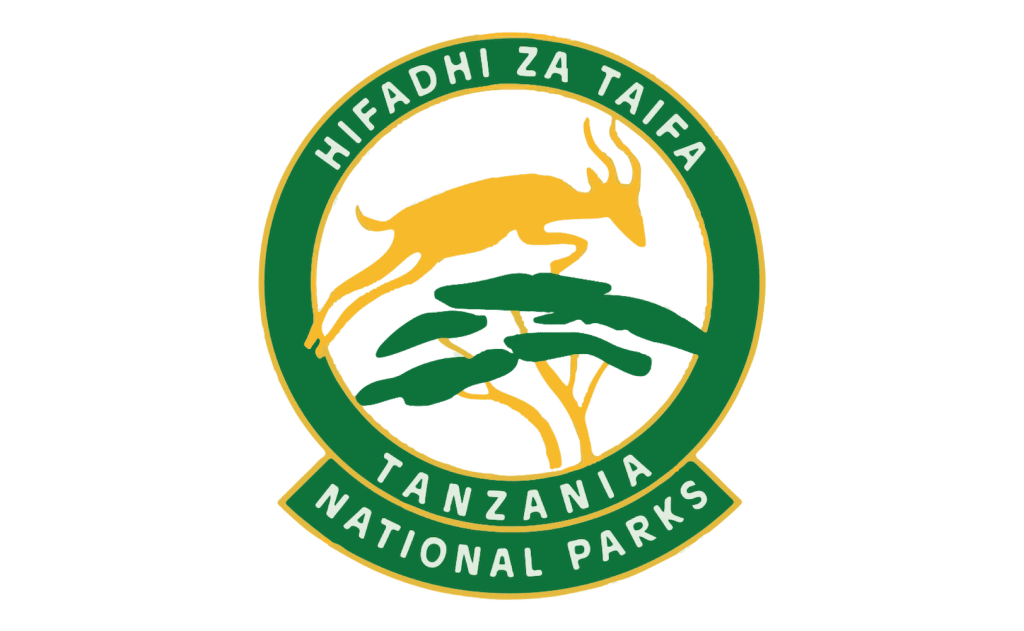
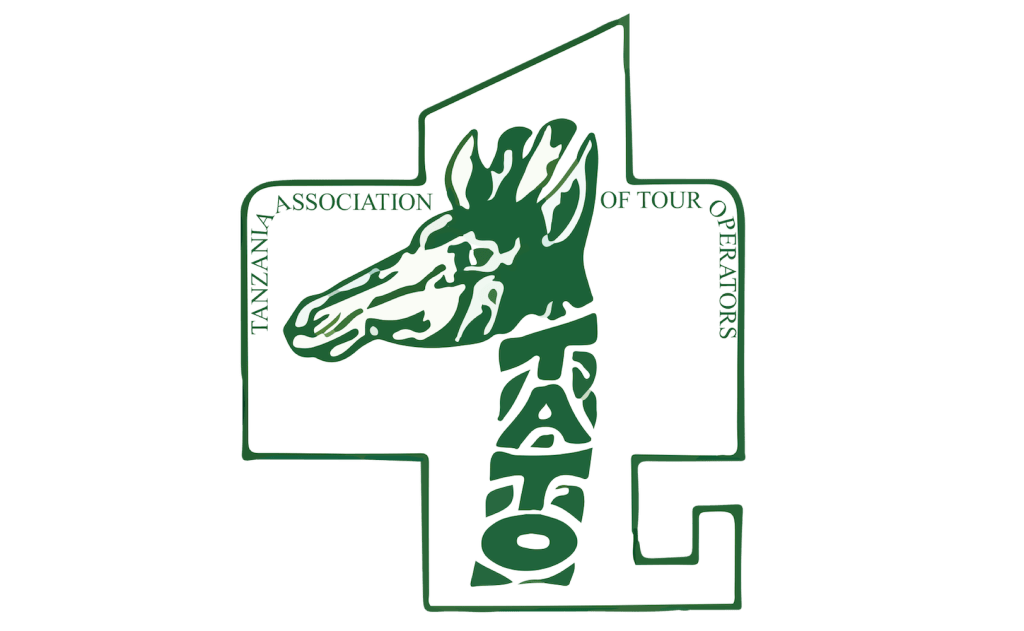
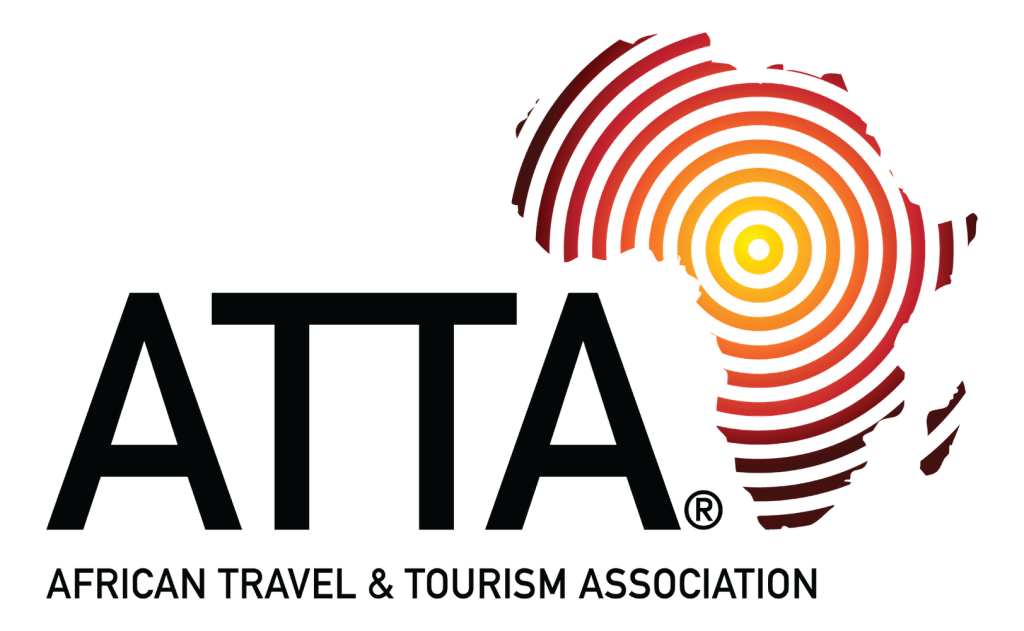
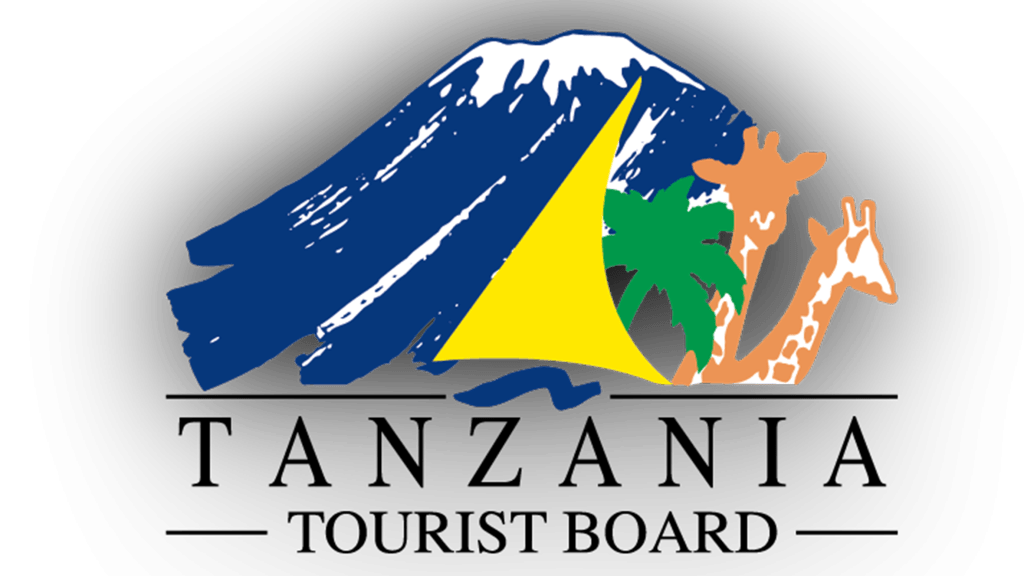
Email Address
info@landsideadventures.com
Call
+255 752 633 454
+255 692 406 444




Email Address
info@landsideadventures.com
Call
+255 752 633 454
+255 784 971 777




